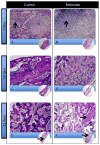Ketorolac administration does not delay early fracture healing in a juvenile rat model: a pilot study
- PMID: 23653032
- PMCID: PMC3907123
- DOI: 10.1097/BPO.0b013e318288b46f
Ketorolac administration does not delay early fracture healing in a juvenile rat model: a pilot study
Abstract
Background: Nonsteroidal anti-inflammatory drugs (NSAIDs) are effective at controlling pain in children, especially in the treatment of fractures. Adult animal and adult clinical studies demonstrate conflicting evidence for the inhibitory relationship between NSAIDs and fracture healing. Published pediatric orthopaedic clinical studies do not demonstrate an inhibitory effect of ketorolac on bone healing. Little is known about the effects of any NSAID on bone formation in juvenile animals. This study investigates the effects of the NSAID ketorolac on fracture healing in a juvenile rat model.
Methods: Unilateral surgically induced and stabilized tibial shaft fractures were created in 45 juvenile (3 to 4 wk old) male Sprague-Dawley rats. Either ketorolac (5 mg/kg; n=24) or saline (0.9% normal saline; n=21) was then administered to the rats 6 d/wk by intraperitoneal injections. Animals were then randomly assigned into time groups and euthanized at 7 days (n=8 ketorolac, n=7 saline), 14 days (n=8 ketorolac, n=7 saline), or 21 days (n=8 ketorolac, n=7 saline) postfracture. Biomechanical analysis was performed using a custom-designed 4-point bending loading apparatus. Statistics for tibial stiffness and strength data were performed using software package Systat 11. Specimens were also evaluated histologically using hematoxylin and eosin staining.
Results: Strength and stiffness of all fractured tibiae increased over time from day 7 to day 21 regardless of treatment type. No statistical difference was found between the fractured tibiae strength or stiffness in the ketorolac or control-treated specimens at the same time point. In addition, the quality of the fracture callus was similar in both groups at each of the time points.
Conclusions: In this study of a juvenile rat model with a stabilized tibia fracture, fracture callus strength, stiffness, and histologic characteristics were not affected by the administration of ketorolac during the first 21 days of fracture healing.
Clinical relevance: The absence of inhibitory effects of ketorolac on early juvenile rat fracture healing supports the clinical practice of utilizing NSAIDs for analgesia in children with long bone fractures.
Conflict of interest statement
The authors declare no conflict of interest.
Figures




References
-
- Drendel AL, Gorelick MH, Weisman SJ, et al. A randomized clinical trial of ibuprofen versus acetaminophen with codeine for acute pediatric arm fracture pain. Ann Emerg Med. 2009;54:553–560. - PubMed
-
- Koller DM, Myers AB, Lorenz D, et al. Effectiveness of oxycodone, ibuprofen, or the combination in the initial management of orthopedic injury-related pain in children. Pediatr Emerg Care. 2007;23:627–633. - PubMed
-
- Clark E, Plint AC, Correll R, et al. A randomized, controlled trial of acetaminophen, ibuprofen, and codeine for acute pain relief in children with musculoskeletal trauma. Pediatrics. 2007;119:460–467. - PubMed
-
- Munro HM, Walton SR, Malviya S, et al. Low-dose ketorolac improves analgesia and reduces morphine requirements following posterior spinal fusion in adolescents. Can J Anaesth. 2002;49:461–466. - PubMed
-
- Sutters KA, Shaw BA, Gerardi JA, et al. Comparison of morphine patient-controlled analgesia with and without ketorolac for post-operative analgesia in pediatric orthopedic surgery. Am J Orthop. 1999;28:351–358. - PubMed
Publication types
MeSH terms
Substances
Grants and funding
LinkOut - more resources
Full Text Sources
Other Literature Sources
Medical

